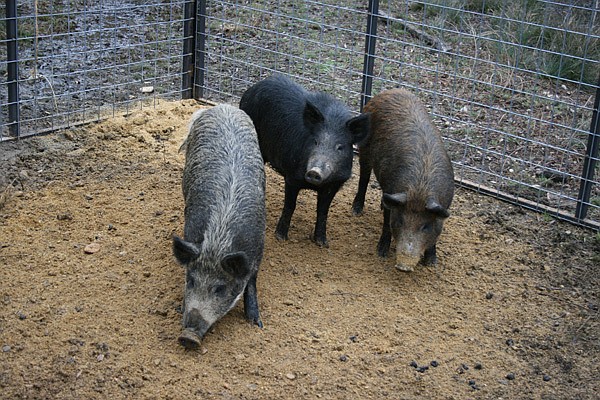State’s hunt for feral hogs intensifying
Wildlife enforcers taking ideas at statewide meetings
The feral hog population has increased throughout the state since Arkansas Game and Fish Commission officials began tracking the animals in the early 1980s.
Thursday, January 24, 2013
Arkansas wildlife management officials plan to intensify their efforts to reduce the feral hog population in the state.
Beginning with a public meeting Tuesday in Fayetteville, members of the Arkansas Game and Fish Commission will begin a public discussion of new approaches to reduce the hogs’ numbers on public land. The 7 p.m. meeting will be at the Ozark Electric Cooperative Corp. building on Wedington Drive and will be the first of a series of public meetings held around the state.
Feral hogs, which are believed to have been first brought to North America by European explorers as early as the 15th century, are considered an invasive species and are notoriously destructive, uprooting both private farm land and public wildland in search of roots and other buried edibles.
The average adult feral hog, male or female, weighs about 300 pounds, although rare specimens reaching 700 pounds have been documented, said James Baker, state biologist for the Natural Resources Conservation Service in Little Rock. Most of the feral hogs found in Arkansas were domesticated within the past 12 generations, Baker said, before being released into the wild, intentionally orunintentionally.
Baker added that the hogs tend to run away when confronted by humans, although a sow may become aggressive if forced to protect her young.
Wildlife officials do not have an estimation for the feral hog population in Arkansas but can map their presence based on reported sightings and evidence of breeding.
Ray Wiggs, wildlife management supervisor with the conservation service’s northwest regional office in Eureka Springs, said he and other wildlife-management employees want to use a systematic approach to trapping and killing feral hogs.
“We’ve been incidentally trapping and shooting piecemeal,” Wiggs said. “We’ve just been doing it when we have time. This will be more of a concentrated effort - a saturation method, where we drop everything else we’re doing, and just trap pigs for a period of time.”
According to Game and Fish regulations, feral hogs may be hunted on private property using any commonly accepted method and on public land during daylight hours using whatever weapon is legal for that season, such as modern rifles or longbows.
In addition to a concentrated trapping effort, the commission also is considering temporarily banning hog hunting on public land to reduce hunters’ temptation to release the animals into the wild, Wiggs said.
“In the past, we’ve invited people to kill every hog they see,” Wiggs said. “But what that’s done is encourage some people to perpetuate it by ‘hog dumping,’ so they can hunt year-round.”
State officials don’t distinguish between formerly domestic hogs roaming freely and the feral population.
Releasing pigs into the wild is a violation of Arkansas Code 2-38-504. Individuals convicted of violating the law may be fined $1,000 per hog released.
Many private landowners in Arkansas - particularly farmers and others who live in rural areas of the state - are personally familiar with the havoc the animals can wreak in a relatively short period of time.
Jason Carte, a construction worker whose family raises beef cattle on 300 to 400 acres south of Prairie Grove, said he and other family members killed about 20 feral hogs on their property in 2011.
“They’ll just root under a barbed wire fence, and then pretty well destroy a field,” Carte said. “They can do massive damage pretty quick.”
In addition to destroying fertile crop soil, feral hogs also aggressively compete for limited resources in the wild. Baker said the pigs endanger native wildlife because of their voracious appetites.
“Acorns, insects, meat - hogs will eat anything. They’re omnivores,” Baker said. “They’re intelligent animals. Once they find a food source, they’re pretty good at exploiting it.”
The swine also reproduce rapidly, with sows giving birth to two to three litters of as many as twelve piglets each in one year, Baker said.
Finally, about 10 percent of feral hogs carry swine brucellosis, a disease that triggers miscarriages in any hog that contracts the virus, and the pseudorabies virus, which has similar symptoms to rabies. People can contract brucellosis, which results in a fever treatable with antibiotics but that may also be debilitating for months.
George Pat Badley, the state veterinarian for the Arkansas Livestock and Poultry Commission, said the hogs’ propensity for disease poses a dire threat to the state’s commercial swine industry. Arkansas’ commercial herd is considered free of both diseases, he said.
“If those diseases get into the commercial herds, we can lose our disease-free status, and it would be a mess for our state’s industry. It would become very difficult to export our swine out of state.”
Wiggs said he has no illusions about quickly solving the state’s infestation.
“It’s a daunting task,” Wiggs said. “In the Great Smoky Mountains, they’ve been working on their hog problem for 50 years, and they’re just breaking even.”
Northwest Arkansas, Pages 7 on 01/24/2013
